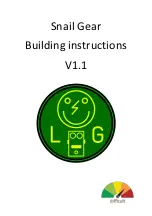
Snail Gear v1.1
5
General guideline for components
Capacitors: All values under 1nF should be ceramic disks or silver mica. From 1nF up to 1uF
should be SMF (Panasonic stacked metal film) or MKT (Metallized plastic polyester) and
values over 1uF use electrolyte caps 16V+ rated and watch out for polarity.
Resistors: use 1% metal film for the best results.
Socket the IC’s. This way you can easily mod them or replace them if they break.
Orientation of the transistors: the white stripe on the PCB indicates where the flat side of the
transistor should be except for Q2, that one the bold side is facing the white stripe.
General building tips
Before you start you will need to make sure that you match the Hfe of Q5 and Q6 for the best result.
Matching is done by using a Digital Multi Meter (DMM). Get them as close together as possible. You
can use any BC549A/B/C or even BC550A/B/C for Q1,Q3,Q4,Q5 and Q6. For Q2 you can only use a
2SK30A or a 2N5457, but the pinout is different so you’ll need to use the extra D pad for the 2N5457:
The original Attack pot is B20K. You can easily use the readily available B25K or you can place a 100K
resistor between pins 1 and 3 to lower the B25K to B20K.
B25K
100k
Soldering this board can be very complicated for some people since the solder pads are very close
together. Use a magnifying glass to make the job easier. If you want to experiment with other
transistors than you could socket them instead of soldering them to the board. You’ll need a 20 SIL,
break off the sockets and solder them to the board.
Start by soldering D2-D4 and then solder the resistors (but not yet VR3) and then D1.
Note:
Diodes are fragile!! Do not expose them to heat for too long or they’ll break. Do not blow on
your solder in an attempt to cool it down. That will possibly result in a bad join that might corrode!
Next, solder the IC sockets, and transistors or if desired the transistor sockets (only if you want to try
different transistors!) then the VR3 and MKT. Lastly solder the electrolyte capacitors.
Place the IC (and transistors) and you are almost ready to rock. The flat sides of the transistor are
indicated by the thick white line.
X
X









